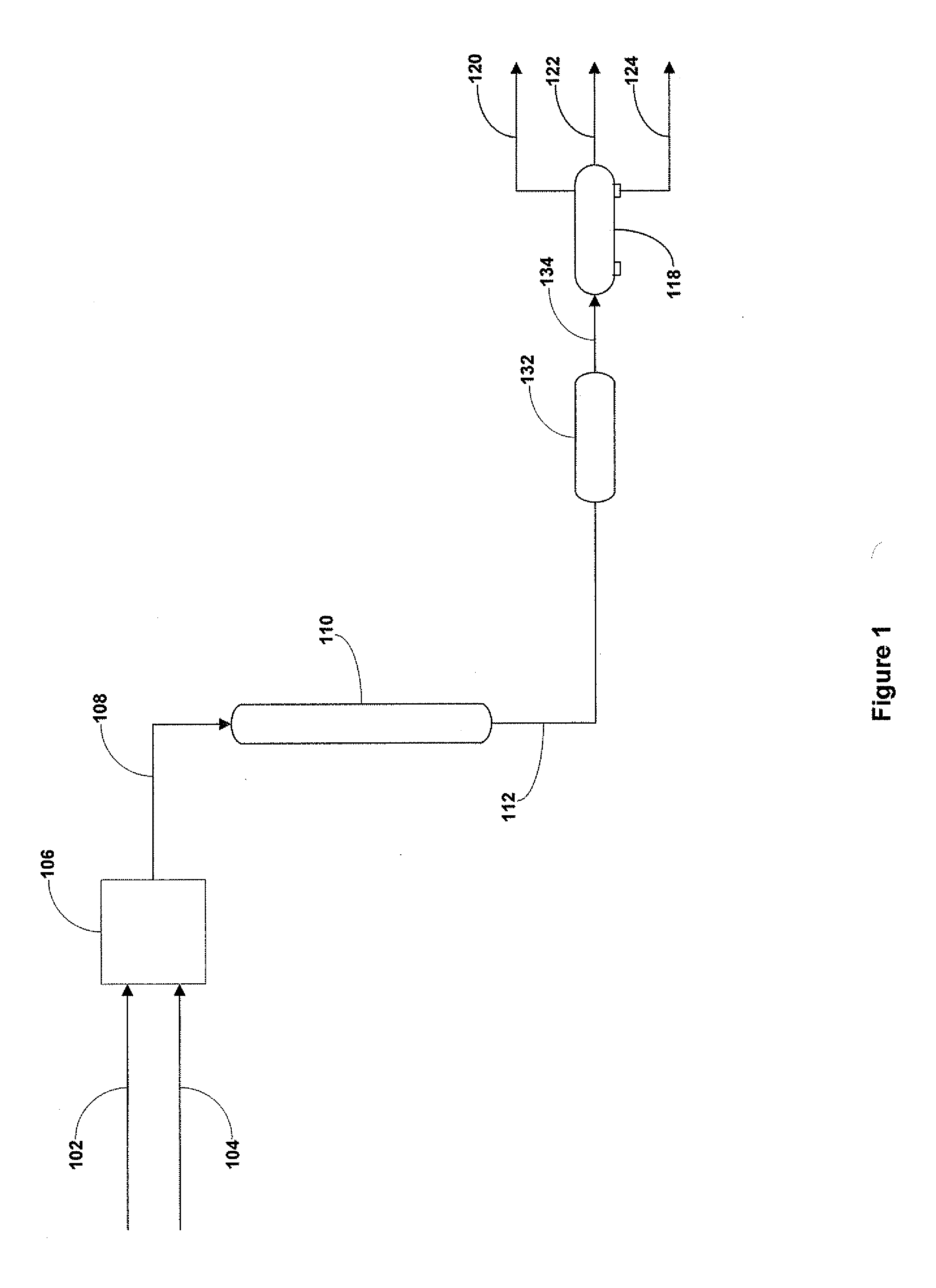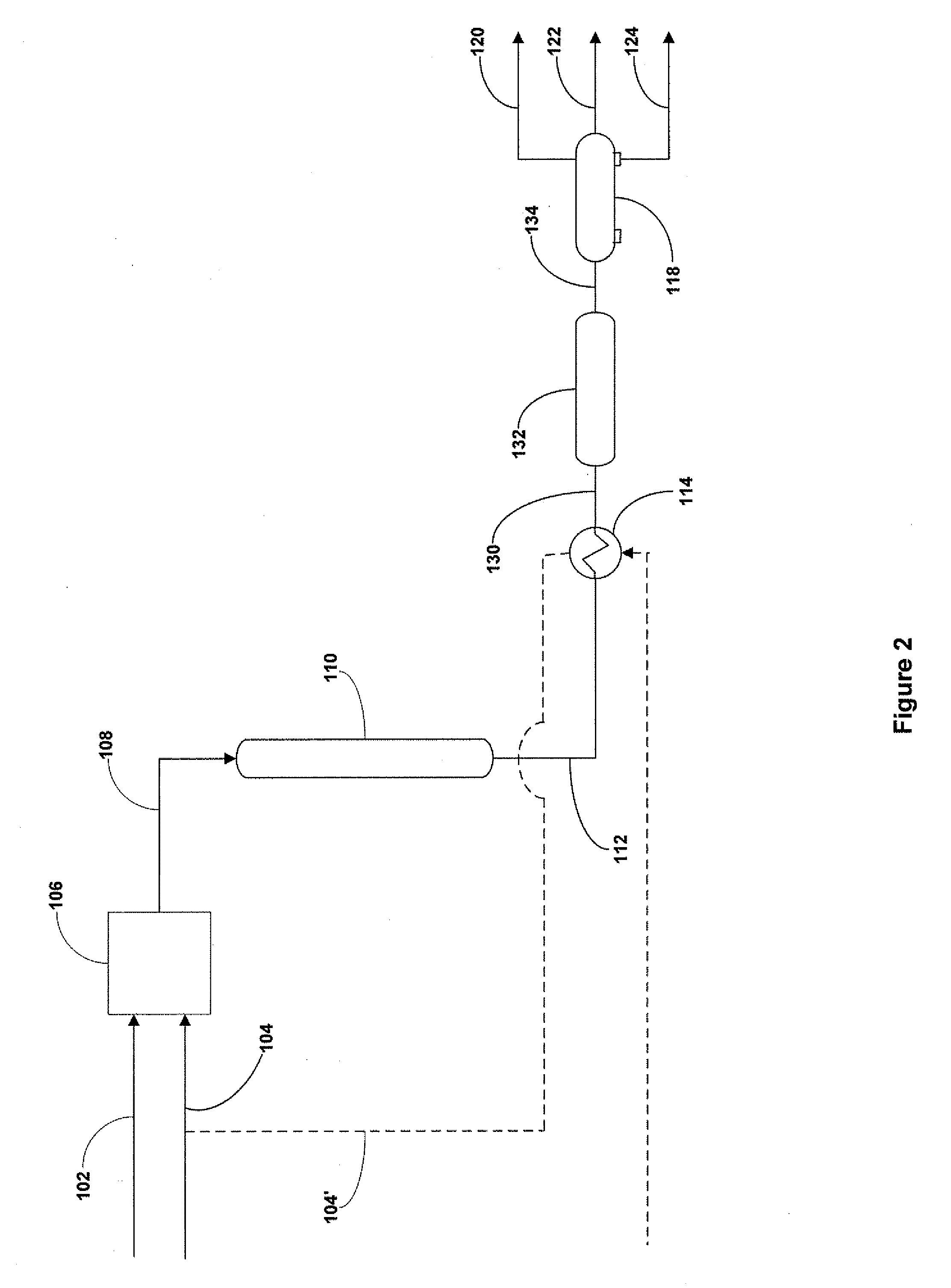Petroleum Upgrading Process
a petroleum product and upgrading technology, applied in the direction of hydrocarbon oil cracking, chemical/physical/physicochemical processes, naphtha treatment, etc., can solve the problems of thermal methods that are used in the majority of the time, process unit downtime, etc., and achieve the effect of reducing the overall size of the hydrothermal reactor 110 and reducing the residence tim
- Summary
- Abstract
- Description
- Claims
- Application Information
AI Technical Summary
Benefits of technology
Problems solved by technology
Method used
Image
Examples
example 1
[0045]Whole range Arabian Heavy crude oil and deionized water are pressurized to a pressure of about 25 MPa utilizing separate pump. The volumetric flow rates of crude oil and water, standard conditions, are about 3.1 and 6.2 mL / minute, respectively. The crude oil and water feeds are pre-heated using separate heating elements to temperatures of about 150° C. and about 450° C., respectively, and supplied to a mixing device that includes simple tee fitting having 0.083 inch internal diameter. The combined crude oil and water feed stream is maintained at about 377° C., above critical temperature of water. The main hydrothermal reactor is vertically oriented and has an internal volume of about 200 mL. The temperature of combined crude oil and water feed stream in the reactor is maintained at about 380° C. The hydrothermal reactor product stream is cooled with a chiller to produce a cooled product stream, having a temperature of approximately 60° C. The cooled product stream is depressur...
example 2
[0046]Whole range Arabian Heavy crude oil and deionized water are pressurized with pumps to a pressure of about 25 MPa. The volumetric flow rates of the crude oil and water at standard condition are about 3.1 and 6.2 ml / minute, respectively. The petroleum and water streams are preheated using separate heaters, such that the crude oil has a temperature of about 150° C. and the water has a temperature of about 450° C., and are supplied to a combining device, which is a simple tee fitting having a 0.083 inch internal diameter, to produce a combined petroleum and water feed stream. The combined petroleum and water feed stream is maintained at a temperature of about 377° C., above the critical temperature of water and supplied to the main hydrothermal reactor, which has an internal volume of about 200 ml and is vertically oriented. The temperature of the combined petroleum and water feed stream in the hydrothermal reactor is maintained at about 380° C. A first product stream is removed f...
example 3
[0047]Whole range Arabian Heavy crude oil and deionized water are pressurized with pumps to a pressure of about 25 MPa. The volumetric flow rates of the crude oil and water at standard condition are about 3.1 and 6.2 ml / minute, respectively. The petroleum and water streams are preheated using separate heaters, such that the crude oil has a temperature of about 150° C. and the water has a temperature of about 450° C., and are supplied to a combining device, which is a simple tee fitting having a 0.083 inch internal diameter, to produce a combined petroleum and water feed stream. The combined petroleum and water feed stream is maintained at a temperature of about 377° C., above the critical temperature of water and supplied to the main hydrothermal reactor, which has an internal volume of about 200 ml and is vertically oriented. The temperature of the combined petroleum and water feed stream in the hydrothermal reactor is maintained at about 380° C. A first product stream is removed f...
PUM
| Property | Measurement | Unit |
|---|---|---|
| pressure | aaaaa | aaaaa |
| temperature | aaaaa | aaaaa |
| temperature | aaaaa | aaaaa |
Abstract
Description
Claims
Application Information
 Login to View More
Login to View More - R&D
- Intellectual Property
- Life Sciences
- Materials
- Tech Scout
- Unparalleled Data Quality
- Higher Quality Content
- 60% Fewer Hallucinations
Browse by: Latest US Patents, China's latest patents, Technical Efficacy Thesaurus, Application Domain, Technology Topic, Popular Technical Reports.
© 2025 PatSnap. All rights reserved.Legal|Privacy policy|Modern Slavery Act Transparency Statement|Sitemap|About US| Contact US: help@patsnap.com


